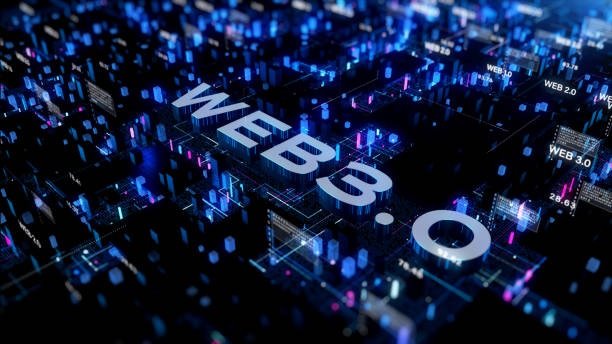Unlock the power of Web 3.0 🌐! Get informed, navigate effortlessly, and exploit the new digital age to your advantage 🔐💡. #Web3.0 #DigitalRevolution
Web 3.0
Web 3.0 represents the evolution of the internet, enhancing user interaction through decentralization and smart technologies. By incorporating blockchain, artificial intelligence, and data interoperability, it aims to create a more intelligent web experience where users have greater control over their information and privacy.
Evolution from the Traditional Web (Web 1.0, 2.0) to Web 3.0
The transition from Web 1.0 to Web 2.0 marked a shift from static content to dynamic user-generated platforms, enhancing interactivity and social engagement. The web 3.0 era introduces semantic understanding, decentralization, and enhanced connectivity, facilitating personalized experiences powered by AI and blockchain technologies.
The potential of Web 3.0
Web 3.0 represents a transformative shift in Internet technology, enhancing user autonomy and promoting decentralized networks. Its potential lies in fostering privacy, security, and interconnectivity through blockchain innovation, enabling individuals to control their data while facilitating new economic opportunities and collaborative platforms.
Fundamental Workings of Web 3.0
Web 3.0 is an advanced evolution of the internet focused on decentralization, leveraging blockchain technology for enhanced security and user control. It fosters intelligent interactions through AI, promotes trust via transparent systems, and enables seamless peer-to-peer connectivity, revolutionizing how users engage online.
Key Characteristics Differentiating Web 3.0 from Its Predecessors
Web 3.0 distinguishes itself from earlier iterations through enhanced decentralization, intelligent data interoperability, and user-centric privacy. By integrating blockchain technology and aiming for a semantic web, it empowers individuals with greater control over personal information while fostering transparency and trust within digital ecosystems.
The Technology Behind Web 3.0: Artificial Intelligence, Machine Learning & Semantic Web
Web 3.0 revolves around advanced technologies like Artificial Intelligence, Machine Learning, and the Semantic Web. These innovations enable smarter data interactions and personalized user experiences by interpreting meaning and context in information, allowing for more intuitive web applications that effectively understand user needs.
How Web 3.0 Affects Search Experiences and Data Interaction
Web 3.0 revolutionizes search experiences and data interaction by emphasizing decentralized networks, and enhancing user control over personal information. This evolution allows for more personalized search results, fosters greater transparency in data usage, and improves connectivity among users through smarter, AI-driven technologies.
Benefits of Web 3.0 for Businesses and Consumers
Web 3.0 enhances business and consumer interactions through decentralized applications, ensuring greater privacy and security. It empowers users with data ownership while fostering innovative solutions like smart contracts, leading to improved trust, more efficient transactions, and a personalized digital experience for everyone involved.
The Role of Web 3.0 in Improving Personalization and User Flexibility
Web 3.0 enhances personalization and user flexibility by leveraging decentralized technologies and advanced data handling. It empowers users with greater control over their data, allowing for tailored experiences that reflect individual preferences while fostering secure interactions in a more interconnected digital environment.
Blockchain, Cryptocurrency, and Decentralized Finance (DeFi)
Blockchain technology enables secure, transparent transactions through distributed ledgers, forming the backbone of cryptocurrencies like Bitcoin and Ethereum. Decentralized finance (DeFi) utilizes these digital currencies to create open financial systems, eliminating intermediaries and granting users greater control over their assets and investments.
Internet of Things (IoT)
The Internet of Things (IoT) refers to the interconnected network of devices that communicate and share data via the Internet. It enhances efficiency, automation, and user experience across various sectors including healthcare, transportation, smart homes, and industrial applications by facilitating real-time information exchange.
Augmented Reality (AR) / Virtual Reality (VR)
Augmented Reality (AR) and Virtual Reality (VR) are advancing technologies that merge digital and physical worlds. AR enhances real environments with virtual elements, while VR creates immersive digital experiences. Both are transforming gaming, education, training, and various other fields through innovative interactions.
The Changing Landscape of Data Privacy in Web 3.0
The evolution of Web 3.0 is reshaping data privacy, emphasizing decentralized technologies and user control over personal information. As blockchain innovations emerge, individuals gain enhanced security, challenging traditional models, fostering transparency, and enabling users to manage their data rights more effectively than ever before.
How Web 3.0 Offers More Control to Users Over Their Data
Web 3.0 empowers users by providing greater control over personal data through decentralized platforms. By utilizing blockchain technology, individuals can manage their information securely, choose visibility settings, and engage directly with applications without intermediaries, ensuring privacy and ownership in the digital landscape.
Challenges Ahead for Data Protection and Regulations on Web 3.0
As Web 3.0 evolves, data protection faces significant challenges, including ensuring user privacy amid decentralized systems and balancing innovation with regulatory compliance. Establishing robust regulations to safeguard personal information while fostering a dynamic digital environment will be crucial moving forward.
Readiness and Adaptability for Businesses and Organizations
Businesses and organizations must prioritize readiness and adaptability to thrive in a constantly evolving environment. This flexibility enables them to respond effectively to market changes, technological advancements, and shifting consumer preferences, ensuring sustained growth and resilience amidst challenges and competition.
Encouraging Digital Skill Development and Learning for Web 3.0
Fostering the growth of digital skills is vital for success in the Web 3.0 era. By promoting education and practical learning opportunities, we can empower individuals to navigate decentralized platforms confidently, enhancing innovation and creating a more inclusive digital landscape for all.
Best Practices and Strategies for Embracing Web 3.0
To effectively embrace Web 3.0, organizations should prioritize user-centric design, invest in decentralized technologies, ensure data privacy, foster community engagement, implement robust security measures, adopt interoperability standards, and continuously educate stakeholders on innovations to create a more inclusive digital ecosystem.







